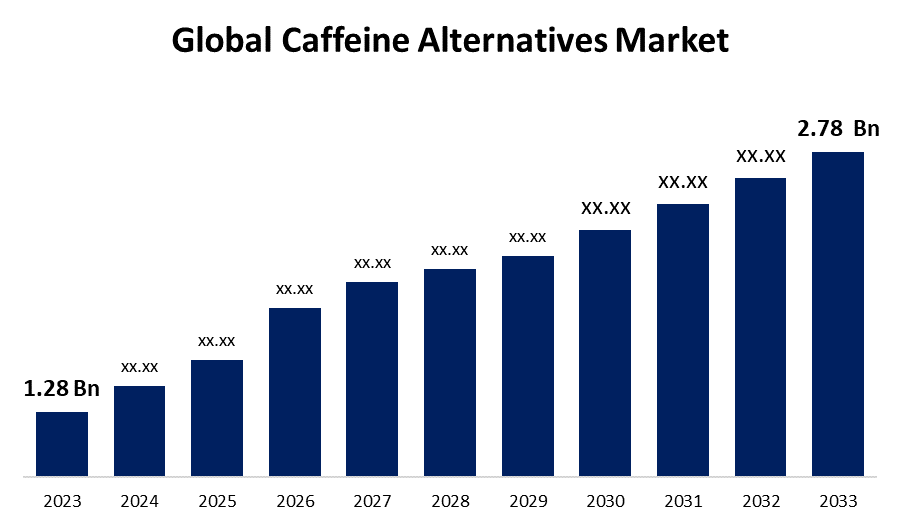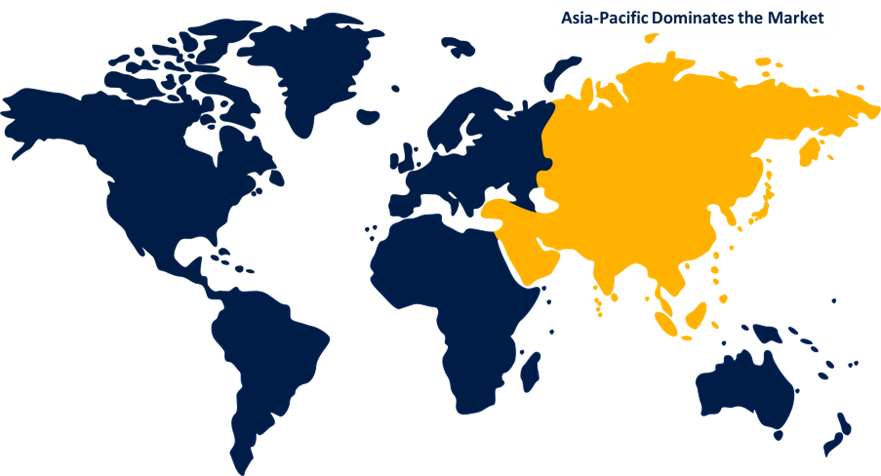Global Caffeine Alternatives Market Size, Share, and COVID-19 Impact Analysis, By Type (Herbal Alternatives, Grain-Based Alternatives), By Form (Powder, Liquid, Capsules/Tablets), By Distribution Channel (Hypermarket/Supermarket, Convenience Stores, Online), and By Region (North America, Europe, Asia-Pacific, Latin America, Middle East, and Africa), Analysis and Forecast 2023 - 2033
Industry: Food & BeveragesGlobal Caffeine Alternatives Market Insights Forecasts to 2033
- The Global Caffeine Alternatives Market Size was Valued at USD 1.28 Billion in 2023
- The Market Size is Growing at a CAGR of 8.06% from 2023 to 2033
- The Worldwide Caffeine Alternatives Market Size is Expected to Reach USD 2.78 Billion by 2033
- Europe is Expected to Grow the fastest during the forecast period.

Get more details on this report -
The Global Caffeine Alternatives Market Size is Anticipated to Exceed USD 2.78 Billion by 2033, Growing at a CAGR of 8.06% from 2023 to 2033.
Market Overview
Caffeine is a xanthine alkaloid naturally present in the fruits, seeds, and leaves of plants like guarana, coffee, and tea. It is commonly included in medications for migraines and headaches. In contrast, caffeine alternatives are products with little to no caffeine. These alternatives are considered healthier options since they have minimal impact on the nervous system. The demand for caffeine alternatives has markedly increased as consumers increasingly prioritize health and wellness. These alternatives provide energy and enhance productivity without the adverse effects commonly associated with caffeine consumption. This trend signifies a significant shift toward health consciousness among consumers, driving the market for non-stimulant energy products. The caffeine alternative market offers a wide array of products designed to provide consumers with effective energy and productivity boosts without the drawbacks of caffeine. This includes herbal infusions, dietary supplements, energy elixirs, and a variety of functional beverages. These healthier alternatives help consumers steer clear of negative side effects like anxiety, restlessness, and insomnia, promoting a more balanced approach to energy enhancement. Heightened consumer awareness of the benefits of caffeine alternatives, including better metabolic support, stress relief, and enhanced cognitive function, is driving global caffeine alternatives market growth.
Report Coverage
This research report categorizes the market for the global caffeine alternatives market based on various segments and regions forecasts revenue growth and analyzes trends in each submarket. The report analyses the key growth drivers, opportunities, and challenges influencing the global caffeine alternatives market. Recent market developments and competitive strategies such as expansion, product launch, and development, partnership, merger, and acquisition have been included to draw the competitive landscape in the market. The report strategically identifies and profiles the key market players and analyses their core competencies in each sub-segment of the global caffeine alternatives market.
Global Caffeine Alternatives Market Report Coverage
| Report Coverage | Details |
|---|---|
| Base Year: | 2023 |
| Market Size in 2023: | USD 1.28 Billion |
| Forecast Period: | 2023 – 2033 |
| Forecast Period CAGR 2023 – 2033 : | 8.06% |
| 023 – 2033 Value Projection: | USD 2.78 Billion |
| Historical Data for: | 2019-2021 |
| No. of Pages: | 175 |
| Tables, Charts & Figures: | 105 |
| Segments covered: | By Type, By Form, By Distribution Channel, and By Region |
| Companies covered:: | World Finer Foods, Unilever, Gourmesso Coffee, Douwe Egberts, Dualit, Nestle, Dilmah Ceylon Tea Company PLC, Ippodo Tea, Tranquini, Chillbev, Som Sleep, Phi Drinks, Inc., Rasa, and Others |
| Pitfalls & Challenges: | COVID-19 Empact,Challenges, Future, Growth, & Analysis |
Get more details on this report -
Driving Factors
The caffeine substitute market is growing quickly due to changing consumer preferences and a rising focus on health. As people become more health-conscious worldwide, they are actively seeking alternatives to traditional caffeinated drinks like coffee and energy beverages. Caffeine alternatives are in high demand due to their rich content of prebiotic fibre, which aids in weight loss and enhances digestive health. Additionally, they provide essential nutrients like manganese and vitamin B6, which are crucial for brain health. These benefits have significantly increased the appeal of caffeine alternatives, contributing to the global caffeine alternatives growth of the market.
Restraining Factors
High manufacturing costs for caffeine alternatives, compared to the lower production costs of conventional coffee using synthetic chemicals, are likely to restrict market growth in the forecast period. Additionally, the presence of various alternative caffeine alternatives will further hamper global caffeine alternatives market expansion.
Market Segmentation
The global caffeine alternatives market share is classified into type, form, and distribution channel.
- The herbal alternatives segment is expected to hold the largest share of the global caffeine alternatives market during the forecast period.
Based on the type, the global caffeine alternatives market is categorized into herbal alternatives, and grain-based alternatives. Among these, the herbal alternatives segment is expected to hold the largest share of the global caffeine alternatives market during the forecast period. Consumer preference for natural and organic products is driving the market for herbal alternatives, viewed as healthier alternatives to synthetic options. This trend aligns with the growing focus on wellness and clean-label products. Moreover, herbal alternatives often provide additional health benefits, including stress relief, better digestion, and antioxidant properties
- The powder segment is expected to grow at the fastest CAGR during the forecast period.
Based on the form, the global caffeine alternatives market is categorized into powder, liquid, capsules/tablets. Among these, the powder segment is expected to grow at the fastest CAGR during the forecast period. Powdered alternative offer convenience and flexibility, making them perfect for busy consumers looking for quick options. They can easily be added to drinks like shakes and smoothies, catering to various nutritional needs. Additionally, powdered products typically have longer shelf lives and require less storage space than liquids, benefiting both retailers and customers. Recent advancements in formulation have also enhanced taste and solubility, improving the overall experience.
- The hypermarket/supermarket segment is predicted to dominate the global caffeine alternatives market during the forecast period.
Based on the distribution channel, the global caffeine alternatives market is categorized into hypermarket/supermarket, convenience stores, and online. Among these, the hypermarket/supermarket segment is predicted to dominate the global caffeine alternatives market during the forecast period. Supermarkets and hypermarkets provide a diverse selection of products, including coffee substitutes, making them convenient one-stop shopping destinations. As these retailers expand their offerings, they attract customers seeking both traditional and alternative options. Their variety includes herbal teas, decaffeinated coffee, caffeine-free energy drinks, and more, encouraging shoppers to explore and buy these products, which boosts overall sales.
Regional Segment Analysis of the Global Caffeine Alternatives Market
- North America (U.S., Canada, Mexico)
- Europe (Germany, France, U.K., Italy, Spain, Rest of Europe)
- Asia-Pacific (China, Japan, India, Rest of APAC)
- South America (Brazil and the Rest of South America)
- The Middle East and Africa (UAE, South Africa, Rest of MEA)
Asia-Pacific is projected to hold the largest share of the global caffeine alternatives market over the forecast period.

Get more details on this report -
Asia-Pacific is projected to hold the largest share of the global caffeine alternatives market over the forecast period. Consumer awareness and demand for healthier lifestyle choices are soaring in this region. Many are now seeking alternatives to traditional caffeinated beverages like coffee and energy drinks, motivated by health, wellness, and sustainability concerns. This shift is reinforced by a thriving market for organic and natural products, where caffeine alternatives are celebrated for their health benefits and eco-friendly sourcing. The region also boasts a vibrant food and beverage industry that continually innovates, offering a diverse range of caffeine-free options such as herbal teas, decaffeinated drinks, and functional beverages that deliver energy through natural ingredients.
Europe is expected to grow at the fastest CAGR growth of the global caffeine alternatives market during the forecast period. Consumer awareness and demand for healthier choices are rapidly increasing in this region. Many individuals are turning to alternatives to traditional caffeinated beverages, such as coffee and energy drinks, driven by health, wellness, and sustainability concerns. This trend is bolstered by a flourishing market for organic and natural products, where caffeine alternatives are prized for their health benefits and eco-friendly sourcing. The region's dynamic food and beverage industry continues to innovate, offering a variety of caffeine-free options, including herbal teas, decaffeinated drinks, and functional beverages that provide energy naturally.
Competitive Analysis:
The report offers the appropriate analysis of the key organizations/companies involved within the global caffeine alternatives market along with a comparative evaluation primarily based on their product offering, business overviews, geographic presence, enterprise strategies, segment market share, and SWOT analysis. The report also provides an elaborative analysis focusing on the current news and developments of the companies, which includes product development, innovations, joint ventures, partnerships, mergers & acquisitions, strategic alliances, and others. This allows for the evaluation of the overall competition within the market.
List of Key Companies
- World Finer Foods
- Unilever
- Gourmesso Coffee
- Douwe Egberts
- Dualit
- Nestle
- Dilmah Ceylon Tea Company PLC
- Ippodo Tea
- Tranquini
- Chillbev
- Som Sleep
- Phi Drinks, Inc.
- Rasa
- Others
Key Market Developments
- In January 2023, Rasa introduced two new premixes, Classic Rasa and Café Rasa, featuring mushrooms and adaptogenic herbs. This expansion enhances the company's product portfolio, allowing it to reach a broader audience and cater to diverse demographic groups.
- In October 2022, Nestlé, a prominent food and beverage company, expanded its coffee operations in North America through the acquisition of Seattle's Best Coffee.
Key Target Audience
- Market Players
- Investors
- End-users
- Government Authorities
- Consulting And Research Firm
- Venture capitalists
- Value-Added Resellers (VARs)
Market Segment
This study forecasts revenue at global, regional, and country levels from 2020 to 2033. Spherical Insights has segmented the global caffeine alternatives market based on the below-mentioned segments:
Global Caffeine Alternatives Market, By Type
- Herbal Alternatives
- Grain-Based Alternatives
Global Caffeine Alternatives Market, By Form
- Powder
- Liquid
- Capsules/Tablets
Global Caffeine Alternatives Market, By Distribution Channel
- Hypermarket/Supermarket
- Convenience Stores
- Online
Global Caffeine Alternatives Market, By Regional
- North America
- US
- Canada
- Mexico
- Europe
- Germany
- UK
- France
- Italy
- Spain
- Russia
- Rest of Europe
- Asia Pacific
- China
- Japan
- India
- South Korea
- Australia
- Rest of Asia Pacific
- South America
- Brazil
- Argentina
- Rest of South America
- Middle East & Africa
- UAE
- Saudi Arabia
- Qatar
- South Africa
- Rest of the Middle East & Africa
Frequently Asked Questions (FAQ)
-
1. What is the CAGR of the global caffeine alternatives market over the forecast period?The global caffeine alternatives market Size is expected to grow from USD 1.28 billion in 2023 to USD 2.78 billion by 2033, at a CAGR of 8.06% during the forecast period 2023-2033.
-
2. Which region is expected to hold the highest share of the global caffeine alternatives market?Asia Pacific is projected to hold the largest share of the global caffeine alternatives market over the forecast period.
-
3. Who are the top key players in the caffeine alternatives market?World Finer Foods, Unilever, Gourmesso Coffee, Douwe Egberts, Dualit, Nestle, Dilmah Ceylon Tea Company PLC, Ippodo Tea, Tranquini, Chillbev, Som Sleep, Phi Drinks, Inc., Rasa, Others.
Need help to buy this report?